I recently wrote a guest blog for the Independent Living Center Access Living with Dr. Angel Miles.
COVID-19 has spread rapidly through congregate care settings such as nursing homes, subjecting many old and disabled people and care workers to severe, debilitating illness and death. There are estimates that 30% of COVID-19 deaths are connected to nursing homes, and in some states like Illinois, that percentage increases to 50%. Advocates and policy makers have called for "more funding" so that nursing homes can better respond to this crisis, but Dr. Miles and I argue in this blog post that this is not the answer--instead, our society must fund home and community-based services so that people are not forced to live in nursing homes and other institutions in the midst of a deadly global pandemic. #FreeThemAll
"Relying on institutions to care for people with disabilities is no longer sustainable and perpetuates health disparities—endangering entire communities, particularly in the midst of a global pandemic. That’s unacceptable especially when we know that Home and Community-Based Services allow disabled people to receive the care and support they need while remaining in their homes and communities."
Read the entire blog here: https://www.accessliving.org/newsroom/blog/amid-the-nursing-home-crisis-home-and-community-based-services-should-take-center-stage/
COVID-19 has spread rapidly through congregate care settings such as nursing homes, subjecting many old and disabled people and care workers to severe, debilitating illness and death. There are estimates that 30% of COVID-19 deaths are connected to nursing homes, and in some states like Illinois, that percentage increases to 50%. Advocates and policy makers have called for "more funding" so that nursing homes can better respond to this crisis, but Dr. Miles and I argue in this blog post that this is not the answer--instead, our society must fund home and community-based services so that people are not forced to live in nursing homes and other institutions in the midst of a deadly global pandemic. #FreeThemAll
"Relying on institutions to care for people with disabilities is no longer sustainable and perpetuates health disparities—endangering entire communities, particularly in the midst of a global pandemic. That’s unacceptable especially when we know that Home and Community-Based Services allow disabled people to receive the care and support they need while remaining in their homes and communities."
Read the entire blog here: https://www.accessliving.org/newsroom/blog/amid-the-nursing-home-crisis-home-and-community-based-services-should-take-center-stage/





 RSS Feed
RSS Feed
